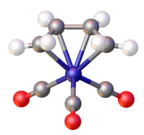(Butadiene)iron tricarbonyl

| |
| Identifiers | |
|---|---|
3D model (JSmol)
|
|
| EC Number |
|
PubChem CID
|
|
| |
| |
| Properties | |
| C7H6FeO3 | |
| Molar mass | 193.967 g·mol−1 |
| Appearance | yellow oil |
| Melting point | 19 °C (66 °F; 292 K) |
Except where otherwise noted, data are given for materials in their standard state (at 25 °C [77 °F], 100 kPa).
| |
(Butadiene)iron tricarbonyl is an organoiron compound with the formula (C4H6)Fe(CO)3. It is the simplest and most studied metal complex of butadiene. It is an orange colored oil that freezes just below room temperature. The compound adopts a piano stool structure.[1]
The complex was first prepared by heating iron pentacarbonyl with the diene.[2]
Related compounds
Iron(0) complexes of conjugated dienes have been extensively studied. In the butadiene series, (η2-C4H6)Fe(CO)4 and (η2:η2-C4H6)(Fe(CO)4)2 have been crystallized.[3] Many related complexes are known for substituted butadienes and related species. The species (η4-isoprene)iron tricarbonyl is chiral.[4] Cyclobutadieneiron tricarbonyl is a related complex.
References
- ^ Reiss, Guido J. (2010). "Redetermination of (η4-s-cis-1,3-butadiene)tricarbonyliron(0)". Acta Crystallographica Section E. 66: m1369. doi:10.1107/S1600536810039218. PMC 3009352.
- ^ Hans Reihlen; A. Gruhl; G. v. Heßling; O. Pfrengle (1930). "Über Carbonyle und Nitrosyle. IV". Justus Liebigs Annalen der Chemie. 482: 161–182. doi:10.1002/jlac.19304820111.
- ^ Murdoch, H. D.; Weiss, E. (1962). "Butadien-Eisencarbonyl-Verbindungen (Butadieneiron Carbonyl Compounds)". Helvetica Chimica Acta. 45: 1156–61. doi:10.1002/hlca.19620450412.
- ^ Grée, R. (1989). "Acyclic Butadiene-Iron Tricarbonyl Complexes in Organic Synthesis". Synthesis: 341–355. doi:10.1055/s-1989-27250.
